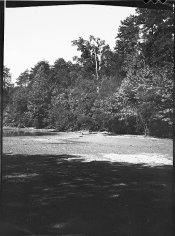Donald Qualls
Subscriber
I discovered today that I exposed two sheets of old TXT through the base side, which I've understood will cost me about five stops.
Yes, I know, the sane thing to do would be to go back and reshoot (the scene is less than a block from home), but for my interest, in case this comes up again (as seems likely, given the frequency with with other LF shooters report similar errors), I'm wondering what I might be able to do to this poor, abused film to get whatever image might be there into the mid-tone densities.
Available to me, I have HC-110, Diafine, Dektol, coffee, vitamin C powder, hydroquinone, potassium iodide, sodium carbonate, borax, and ammonium hydroxide.
The best looking strategy I've found so far has been to dilute some Dektol 1+9, add enough HC-110 syrup to make it Dilution B equivalent, and add 4g/L of the vitamin C powder (plus a teaspoon per liter of sodium carbonate to counter the acidity of the vitamin C), then develop for fifteen minutes at 68 F; this should pull out everything that's in there (I think).
The other option I've considered is using HC-110 Dilution G and just putting the tube on the counter for about an hour, no agitation after the first minute, but this method doesn't have a reputation for increasing contrast in the low zones, so I don't think it's likely to gain much.
Since I have two sheets exposed identically, I'll at least get a second chance if the first is completely useless -- and no, I have no expectation of getting anything worth printing, I'm just interested, at this point, in seeing if I can get anything back from Zone 1.
Has anyone else recovered images from similarly underexposed film, possibly via seriously exotic treatments (latensification, peroxide vapor, perborate bath, etc.)? Latensification might be an option, if I can improvise a suitable light, and I can get 3% peroxide easily enough if peroxide vapor or perborate looks like the way to go, but all of those processes are said to be worth, at most, about one stop above a traditional push, and aren't reported as being additive.
I suppose there's also the possibility of bleaching (I can make a bleach; I have potassium ferricyanide solution for cyanotype) and redeveloping with coffee, possibly multiple times, to intensify the negative via staining (I have a coffee developer formula available that produces little if any general stain, but still some imagewise staining); hydroquinone can also be used to make a simple staining developer.
Yes, I know, the sane thing to do would be to go back and reshoot (the scene is less than a block from home), but for my interest, in case this comes up again (as seems likely, given the frequency with with other LF shooters report similar errors), I'm wondering what I might be able to do to this poor, abused film to get whatever image might be there into the mid-tone densities.
Available to me, I have HC-110, Diafine, Dektol, coffee, vitamin C powder, hydroquinone, potassium iodide, sodium carbonate, borax, and ammonium hydroxide.
The best looking strategy I've found so far has been to dilute some Dektol 1+9, add enough HC-110 syrup to make it Dilution B equivalent, and add 4g/L of the vitamin C powder (plus a teaspoon per liter of sodium carbonate to counter the acidity of the vitamin C), then develop for fifteen minutes at 68 F; this should pull out everything that's in there (I think).
The other option I've considered is using HC-110 Dilution G and just putting the tube on the counter for about an hour, no agitation after the first minute, but this method doesn't have a reputation for increasing contrast in the low zones, so I don't think it's likely to gain much.
Since I have two sheets exposed identically, I'll at least get a second chance if the first is completely useless -- and no, I have no expectation of getting anything worth printing, I'm just interested, at this point, in seeing if I can get anything back from Zone 1.
Has anyone else recovered images from similarly underexposed film, possibly via seriously exotic treatments (latensification, peroxide vapor, perborate bath, etc.)? Latensification might be an option, if I can improvise a suitable light, and I can get 3% peroxide easily enough if peroxide vapor or perborate looks like the way to go, but all of those processes are said to be worth, at most, about one stop above a traditional push, and aren't reported as being additive.
I suppose there's also the possibility of bleaching (I can make a bleach; I have potassium ferricyanide solution for cyanotype) and redeveloping with coffee, possibly multiple times, to intensify the negative via staining (I have a coffee developer formula available that produces little if any general stain, but still some imagewise staining); hydroquinone can also be used to make a simple staining developer.












